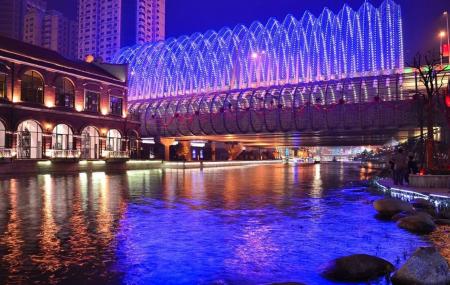7 Must Visit Places
Yellow Crane Tower

Wuhan’s Yellow Crane Tower is the city’s most revered landmark. The building as it currently stands was erected in 1981; however this historical pagoda has been torn down and rebuilt more times than most people care to remember. Once a military watch tower, the five-floor structure now serves purely commemorative purposes. As a source of pride among locals, it’s a universally accepted truth that no trip to Wuhan is complete without climbing to the fifth floor and checking out the bird’s-eye view.
Wuhan Yangtze River Bridge

Wuhan Yangtze River Bridge is the first highway-railway bridge over the Yangtze River. On the mighty Yangtze with a length of 6,300 kilometers (3,915 miles), there was no bridge for thousands of years. This river seemed an obstacle set by nature, separating Hanyang, Hankou and Wuchang, namely the three towns of Wuhan. Moreover, it blocked the transportation between the north and the south China. Only ship can be used. However, the natural obstacle became accessible for various vehicles due to the finish of the Yangtze River Bridge in 1957.
Hebei Provincial Museum
The Hubei Provincial Museum, founded in 1953, is one of the country's eight museums supported by the national government. As the only comprehensive provincial museum, it contains 200,000 cultural relics ranging from ancient jade and bronze vessels, musical instruments, ceramics. It is also Hubei province's most important heritage collection, a research and display institution, and a national tourism site. The Museum is located in a lush garden setting district shade trees, and is laid out in three parts including temporary and comprehensive exhibition halls which feature its collection of exquisite artifacts from the Chu kingdom (770-476 BC). The building design is based on traditional Chu culture's architectural style. The complex features exhibition halls, high platforms, wide, multi-layered eaves, a large sloped roof and three buildings. In its great height, plan and other architectural features it reflects the overall layout Chu axial symmetry of a temple.
East Lake
East Lake, the biggest scenery tourist attraction in Wuhan and also the largest lake within a city in China, is located on the south bank of the Yangtze River and in the east suburb of Wuchang. It covers an area of 87 square kilometers (33 square kilometers of water area) that is five times greater than the area of the West Lake in Hangzhou . Because of its winding banks and crisscrossing ponds and brooks, it is called 'a lake with 99 bays'. The East Lake Scenic Area was formed from many famous scenic spots along the bank. The six major ones are Tingtao (Listening to Surging Waves), Mo Hill (Millstone Hill), Luoyan (Diving Wild Goose), Baima (White Horse), Chuidi (Playing Flutes), and Luohong Hills.
Wuhan Univeristy

Wuhan University (WHU) is a comprehensive and key national university directly under the administration of the Ministry of Education. It is also one of the "211 Project" and "985 Project"universities with full support in the construction and development from the central and local government of China. The history of Wuhan University can be traced back to Ziqiang Institute, which was founded in 1893 by Zhang Zhidong, the then governor of Hubei Province and Hunan Province in the late Qing Dynasty. In the process of development and evolution, the institute changed its name several times before it was finally named Wuhan National University in 1928. It is one of the earliest comprehensive national universities in modern China. By the end of 1946, the university had established 6 colleges, the colleges of liberal art, law, sciences, engineering, agriculture and medicine. In 2000, an amalgamation of the former Wuhan University, Wuhan University of Hydraulic and Electric Engineering, Wuhan Technical University of Surveying and Mapping, and Hubei Medical University was announced, which ushered in a new era in its 100-odd years of development.
Guiyuan Temple
Guiyuan Buddhist Temple is also called Guiyuan Zen Temple. It stands first among the Four Buddhist Monasteries of Wuhan (the other three are Baotong Zen Temple, Gude Buddhist Temple and Zhengjue Buddhist Temple). It is located on Cuiwei Road of Hanyang District in Wuhan, the largest city in inland China. Guiyuan Buddhist Temple covers an area of 4.67 hectares. It is known for its perfect buildings, ingenious sculptures and rich collections. Many foreign tourists have successively visited the temple to view and admire it, including important political figures from other countries, such as King Sihanouk of Kampuchea, the American Secretary of State Henry Kissinger, the former Prime Minister of Singapore Li Guangyao, and the Japanese Prime Minister Nakasone Yasuhiro.
Chu River and Han Street

Chu River Han Street, located in the Wuchang district of Wuhan, capital city of central China's Hubei Province, has attracted millions of tourists during all holidays. It has become the city's new landmark, local media as well as local people said. Invested by Wanda Group, Chu River Han Street, as the first key project of Wuhan East Lake ecological water network, features in a combination of landscape, ecological projects, cultural exhibition as well as shopping centers. Chu River exhibits soul and beauty of Hubei culture (also called Chu culture) while Han Street is the longest pedestrian street in China with its length of 1,500 kilometers.